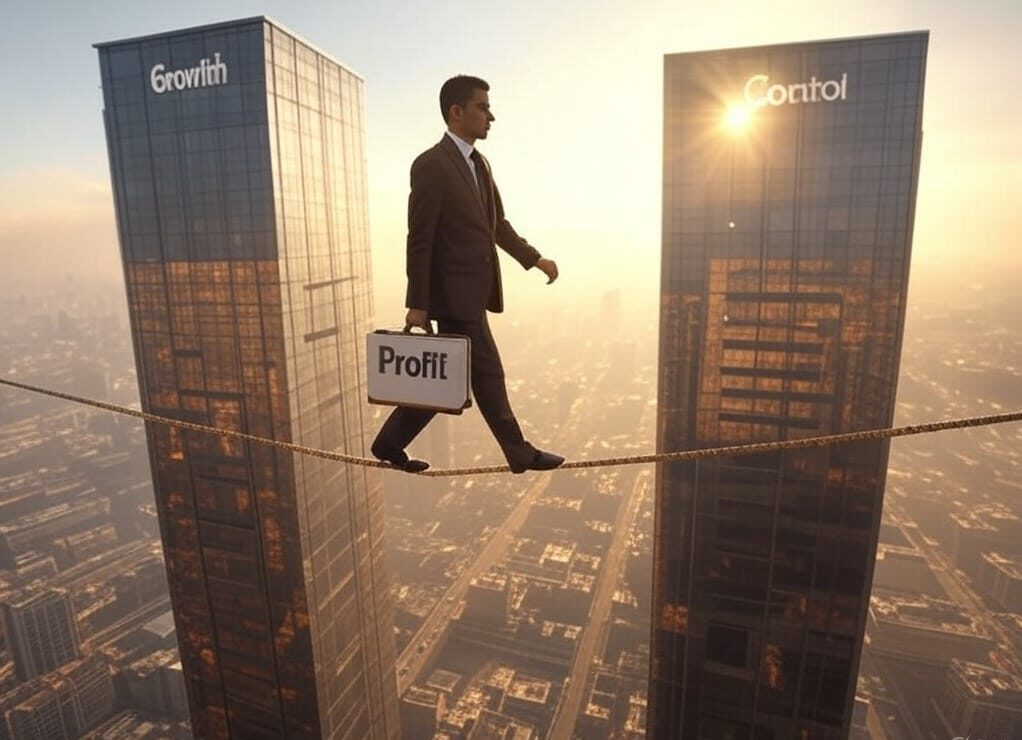
Let’s start with a confession: Scaling a start-up is not about growth.
It’s about survival.
You’ve tasted the adrenaline of early wins—the first 1,000 users, that viral tweet, the angel investor who slid into your DMs. But now? Now you’re staring at the real mountain. The one where “move fast and break things” morphs into “move smart or watch things break.”
I’ve seen founders turn into zombies here. They chase metrics like kids chasing ice cream trucks, only to crash into the harsh truth: Scaling isn’t a spreadsheet exercise. It’s a tightrope walk between ambition and humility, data and instinct, speed and soul.
Let’s ditch the MBA jargon. Here’s how to scale a start-up—without becoming a cautionary tale.
1. The Scaling Lie Everyone Believes (Including Past You)
“If you build it, they will come.”
Let’s unpack this fairy tale. You know what happens when you “build it”? Sometimes, crickets. Sometimes, a stampede. And sometimes, a stampede of crickets.
Scaling isn’t about slapping “10x growth” on a vision board. It’s about orchestrating chaos.
Take the story of Streamline, a SaaS tool that went viral overnight. Their founder, Jake, doubled his team in a week to “keep up with demand.” Six months later? They were drowning in bug reports, churn, and a culture of burnout. Jake confused scaling with sprawling.
Here’s the dirty secret: Scaling is subtraction.
- Bad scaling: Adding 10 new features because competitors have them.
- Real scaling: Removing 7 features to perfect the 3 that users actually need.
Think of your start-up like a cult movie. Blade Runner flopped in theaters but became iconic because it resonated deeply with a niche audience. Scaling isn’t about pleasing everyone—it’s about making your tribe obsessed.
2. The Unsexy Stuff That Actually Moves Needles
A. Automate Like a Chef, Not a Robot
Automation isn’t about replacing humans. It’s about freeing them to be more human.
I worked with a founder who automated her entire customer onboarding—emails, tutorials, the works. Then she noticed something: users signed up… and ghosted. Turns out, automation without soul feels like a DM from a bot.
Her fix?
- Kept the automated emails.
- Added a 20-second video of her team’s dog mascot “approving” each account.
Open rates jumped 65%. Why? Because a golden retriever winking at you beats another “Welcome to our platform!” template.
Automate the mundane. Humanize the meaningful.
B. Hire for “Hell Yes” or Don’t Hire at All
Scaling teams is like drafting a band. You don’t need 10 guitarists. You need a drummer who’s slightly unhinged.
- The Wrong Hire: “I’ll do whatever you need!” (Translation: I’ll coast until my stock vests.)
- The Right Hire: “Your onboarding flow is broken. Here’s how I’d hack it.” (Burns the midnight oil because they’re hooked on the problem.)
At my first start-up, we hired a “growth guru” who quoted Gary Vee in the interview. He lasted 3 weeks. Our best hire? A community college dropout who rebuilt our referral system in a weekend… because she was “bored.”
Scaling isn’t about resumes. It’s about obsession.
C. The Silent Killer Everyone Ignores: Cash Flow Theater
Ah, cash flow—the spreadsheet tab everyone avoids like a dental appointment.
Let’s get real: Profit is punk rock.
I watched a start-up raise $5M, throw rooftop parties, and burn cash on Super Bowl ads. They scaled to 50 employees… and imploded when investors asked, “Where’s the revenue?”
Contrast that with BareMetrics, a bootstrapped SaaS company. They scaled to $4.5M ARR by obsessing over net revenue retention (how much existing customers spend over time). No confetti cannons. Just ruthless focus on profitable growth.
Rule: If your CAC (Customer Acquisition Cost) looks like a phone number, stop scaling. Start fixing.
3. The Hidden Scaling Hack: Strategic No’s
Scaling is a game of refusal.
Picture this: A Fortune 500 CEO emails you: “We’ll pay $250k… if you build a custom AI module in 2 weeks.”
Do you:
A) Panic-hire 10 devs and crash your roadmap?
B) Reply, “Our product doesn’t do that. But here’s what it does do…”
Most founders choose A. The ones who scale sustainably choose B.
Why “No” is your superpower:
- No to “VIP” clients: They’re ego candy. They’ll derail your team for a vanity check.
- No to feature bloat: Slack scaled by ignoring Zoom’s video dominance. They stuck to async communication.
- No to FOMO scaling: Clubhouse rode the audio wave to a $4B valuation… and crashed. Scaling isn’t chasing trends—it’s owning your lane.
Play the long game. Say no to everything that doesn’t scream “hell yes.”
4. When to Burn the Boats (and When to Keep a Canoe)
In 1519, Cortés burned his ships to force conquest mode. For start-ups? Burn the boats metaphorically.
What to burn:
- “Founder knows best” syndrome: You built the MVP. You’re now the bottleneck.
- Meetings about meetings: If it’s not a decision, it’s a distraction.
- Scaling for applause: Vanity metrics (looking at you, “downloads”) are quicksand.
What to keep:
- A “mini start-up” mindset: Spotify’s “squad” model lets teams operate like independent start-ups.
- Pivot agility: Instagram started as a check-in app. They kept the canoe.
A founder I admire scaled her e-commerce brand to 8 countries by doing this:
- Burned HQ’s approval process. Let local teams price products.
- Kept a unified inventory system.
Result? 300% revenue jump.
Scaling isn’t control. It’s controlled chaos.
5. The Scaling Paradox: Grow Big, Stay Small
Redwoods vs. Bamboo
Redwoods are majestic, towering—and hollow at the core. Bamboo? Thin, flexible… and unbreakable. Most start-ups scale like redwoods: impressive on LinkedIn, collapsing in a stiff breeze.
The fix? Be bamboo.
Amazon’s “two-pizza rule” (teams small enough to feed with two pizzas) isn’t about carbs—it’s about curbing bloat. When teams swell beyond 8-10 people, politics replace progress. I saw a fintech start-up crumble because their 20-person “growth squad” spent more time debating T-shirt designs than shipping code.
How to stay small while growing big:
- Tactic 1: ”Grind vs. Grow” Mondays
- Every Monday, categorize tasks:
- Grind: Fixing bugs, answering tickets.
- Grow: Building the next big feature.
- Allocate 70% time to Grow. If you’re not pissing off a few customers with bold changes, you’re not scaling—you’re treading water.
- Every Monday, categorize tasks:
- Tactic 2: Founder “Office Hours” (That Aren’t About You)
- Block 2 hours weekly where any employee can grill you. No agenda.
- A developer once asked me, “Why are we using this garbage CMS?” We switched. Traffic jumped 40%.
- Tactic 3: Kill the Org Chart
- Valve, the gaming giant, has no managers. Employees pick projects like a buffet.
- You don’t need Valve’s anarchy—but flatten hierarchies. Promote “doers” to lead micro-teams. Titles are ego traps.
Cautionary Tale: Quibi
Raised $1.8B, hired Hollywood elites, and built a fortress of bureaucracy. They ignored TikTok’s rise because “meetings about content strategy” replaced making content. They died in 6 months.
6. The Elephant in the Room: You’re the Bottleneck
Founders are control freaks. We’re the reason the MVP shipped… and the reason scaling stalls.
A founder I know coded the first version of his app alone. At 50 employees, he was still approving every CSS change. His CTO quit. His wife threatened divorce. His therapist called it a “messiah complex.”
How to stop choking your company:
- The “Who Does This?” Audit
- List every task you do weekly.
- Highlight tasks only you can do (e.g., investor schmoozing).
- For the rest: Hire, delegate, or eliminate.
- Hire Your Replacement
- Not a COO. Someone better than you at your weaknesses.
- Example: A founder who sucked at operations hired a single mom who’d scaled a bakery chain. She cut costs 30% in 3 months.
- Embrace the “Fuck-Up Framework”
- Tell your team: “You have permission to fail. But fail fast, and tell me why.”
- At ScaleFactor, employees hid mistakes to please the CEO. The $100M start-up imploded.
The Psychology:
Your identity is tied to the start-up. Delegating feels like amputation. But scaling demands you become a gardener, not a sculptor—water the soil, don’t carve the trees.
7. The Finish Line Doesn’t Exist (And That’s the Point)
Scaling isn’t a race. It’s jazz.
Marathons have finish lines. Jazz? It’s improvisation. Miles Davis didn’t “win” jazz—he explored it.
I met a founder who scaled to $10M ARR… and spiraled into depression. “I thought hitting the number would fix everything,” he said. It didn’t.
How to scale without losing your mind:
- Celebrate the Micro-Wins
- A support agent solved a ticket in 2 minutes? Shout it in Slack.
- A designer mocked up a feature “just for fun”? Frame it.
- These moments are oxygen.
- Build a “Culture of Clocks”
- Not literal clocks. Rituals.
- Example: A healthtech start-up does “Failure Fridays”—team shares screw-ups over beers. Vulnerability = trust. Trust = scale fuel.
- Beware the “Scale Hangover”
- Rapid growth creates whiplash. Users complain. Employees burn out.
- Fix: Quarterly “Reset Weeks”—no new projects, just polish. Basecamp does this. Their 20-year survival is no accident.
The Ultimate Test:
Can your start-up survive a month without you? If not, you’ve built a job, not a company.
Final Thought: Scaling Is Parenting (But the Kid Has a Board Seat)
You don’t raise a child to keep them in diapers. You raise them to outgrow you.
- Phase 1: You’re the hero.
- Phase 2: You’re the coach.
- Phase 3: You’re the myth.
A founder friend sold his company for $100M. At the exit party, he sobbed. Not from joy—from realizing he’d become irrelevant to his own creation.
Scale for legacy, not liquidity.
Build something that thrives when you’re gone.
And if you do it right?
You’ll be bored.
And that’s the point.
FAQ Section: Scaling Startups
When is the Best Time to Scale a Startup?
When your customers start begging you to take their money.
Signs you’re ready:
✅ Steady cash flow (profit > ego).
✅ Customers stick like duct tape (retention > 80%).
✅ Your tech stack won’t crash at 2 AM.
What’s the Biggest Mistake Startups Make When Scaling?
Premature scaling. It’s the startup equivalent of proposing on a first date.
Top blunders:
- Hiring a “growth guru” who quotes Gary Vee.
- Chasing vanity metrics (looking at you, “downloads”).
- Ignoring CAC until it looks like a phone number.
What Tools Are Essential for Scaling Startups?
Tools that automate tasks, not empathy.
Must-haves:
- BareMetrics (profit > platitudes).
- Zapier (glue for your tech stack).
- Slack (but only if you mute 90% of channels).
Avoid tools that promise “10x growth in 10 days.” Spoiler: They’re snake oil.
How Do You Measure Successful Scaling?
If your team doesn’t panic when you take a vacation.
Metrics that matter:
- Net Revenue Retention (>100% = customers are addicts).
- CAC Payback Period (<12 months = you’re not burning cash).
- Employee Retention (>80% = your culture isn’t toxic).

